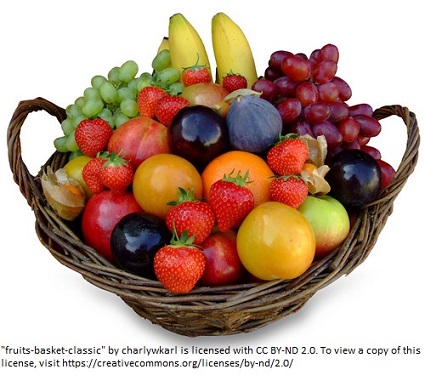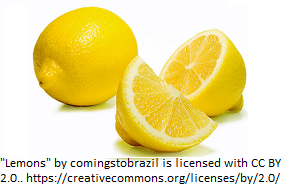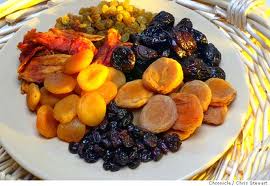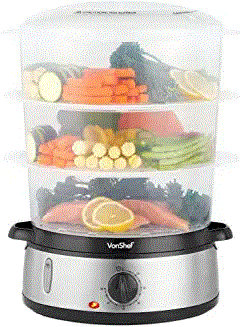
Studies show that on average, organic produce has significantly higher mineral levels than inorganic. A recent $25-million E.U. study found that organic food has 40% more antioxidants, is far more nutritious than ordinary produce, and can improve your health and longevity. Inorganically grown fruits/vegetables typically receive ~10 pesticide treatments from seed to storage. If produce sits in your fridge without deteriorating for weeks -there's a clue! Look for genuinely organic foods, harvested when ripe, preferably from local producers.
If you must economize , the most important foods to purchase organically would be animal products, not fruits and vegetables. Animal products tend to concentrate pesticides more, particularly in their fat (Non-organic meats have up to 5 times more pesticides than non-organic vegetables). The worst contaminated food, however, is NON-organic butter, which has up to 20 times as many pesticides as NON-organic vegetables.
Conventionally grown produce. Has 4-digit PLU code (Eg. 4011)
Genetically modified (GM) produce. Has 5-digit code beginning with 8, but distributors are not legally required to include it, and usually don't, leaving just a 4 digit code
Organic produce. Has 5-digit code, starting with the number 9: (Eg. 94011)
| Environmental Working Group's Shoppers'Guide for Pesticides in Produce 2023 List |
|
|---|---|
| Results of ~ 43,000 tests for pesticides on produce by the USDA and the FDA (Updated Nov. 2006)EWG (a not-for-profit organization) found that consumers could reduce their pesticide exposure by nearly 90% by avoiding the most contaminated fruits and vegetables and eating the least contaminated instead. If eating produce from the "Dirty Dozen", it makes sense to choose organic | |
| The "Dirty Dozen" (starting with the worst) | The "Cleanest 15" (starting with the best) |
| 1. Strawberries | 1. Avocados |
| 2. Spinach | 2. Sweet corn |
| 3. Kale, collard & mustard greens | 3. Pineapple |
| 4. Peaches | 4. Onions |
| 5. Pears | 5. Papaya |
| 6. Nectarines | 6. Sweet peas (frozen) |
| 7. Apples | 7. Asparagus |
| 8. Grapes | 8. Honeydew melon |
| 9. Bell & hot peppers | 9. Kiwi |
| 10. Cherries | 10. cabbage |
| 11. Blueberries | 11. Mushrooms |
| 12. Green beans | 12. Mangoes |
| 13. Sweet potatoes | |
| 14. Watermelon | |
| 15. Carrots | |
Thorough scrubbing and washing reduces pesticides by anywhere from 1/3 to 1/2. Alternatively, some choices to remove pesticides before consumption:
• Spray with 3% Hydrogen peroxide (H2O2 ) solution then rinse
• Soak produce in a baking soda solution for 12 minutes. 1 tsp. baking soda to 1.5 L water (or~a slightly heaped tsp. in 1/2 gal.); a Mass. univ. study showed it reduces pesticides and toxic chemicals to normal levels;
Extend produce life by storing them in bags with as much as possible of the air squeezed out before sealing it. After harvesting, fruits and vegetables release ethylene gas, which accelerates ripening, aging and rotting. Removing air decelerates this process.

Eat 2 pieces/servings FRESH fruit / day. To obtain Vitamin C, Antioxidants, polyphenols, fiber + Eat 1 BANANA: for potassium + other minerals
Limit total fructose intake to <25g / day. <15g if tackling a health problem;
Consider net carb content. Too much fruit, especially high sugar fruits can soon add excessive carbohydrate grams. Net carbs is calculated as total carbs less fiber carbs.
| Highest antioxidant fruits (by serving size) | |||
|---|---|---|---|
| Acai berries | Pomegranate | Wild Blueberries | Cultivated Blueberries |
| Cranberries | Blackberries | Raspberries | Strawberries |
| Red Delicious / Granny Smith Apples | Sweet Cherries | Black Plums | Plums |

Seeds - chew them
Skins - wash thoroughly; contain highest amount of antioxidants
High Vitamin C Fruits : Orange Red Grapes Kiwi Grapefruit
Alkalinity - generally, too much of the Western diet is acid producing. Most (not all) fruit and vegetables provide the alkalizing balance.

All raw fruit (except cranberries, plums and blueberries) have an alkaline effect on the body. Lemons, kiwi, and oranges have a strong alkalizing effect on the body.
Lemon Juice is a health-promoting alkalizing drink
Cooked fruit (includes processed fruit juices) has an acid affect on the body

Vitamin C was measured in 8oz glass OJ made from samples taken at the point of manufacture:
• OJ made from frozen concentrated OJ -173% DV
• OJ from concentrate -161.2% DV
• Pasteurized OJ -138.4% DV

Frozen concentrated OJ retains its vitamin C much better than ready-to-drink OJ in glass or cardboard containers:
• You can add spring water -Reconstituted OJ has water from dubious sources.
• Keep on-hand in freezer - Takes up little space.
However, you may want to stay clear of OJ altogether . . .
• OJ contains too much fructose (25g in 8oz glass, ~8 tsp. sugar. Almost as much as a can of soda). Over-consumption of fructose (>25g/day) spikes blood sugar, a known factor in INSULIN-resistance/diabetes/obesity, high blood pressure and heart disease.
• Commercial OJ resembles nothing found in nature. Even though the label states "Freshly-squeezed" and "Not-from-concentrate", after the oranges are squeezed, the oxygen is removed from the juice as it is stored in up to million gallon holding tanks, allowing it to keep for up to a year without spoiling. However, this process also makes the juice completely flavorless, so the industry hire flavor and fragrance companies to engineer flavor packs to re-flavor the juice.
• Any fruit juice stored in cans or containers contain unbound methanol which increases risk of M.S.. The neurotoxin methanol in stored juice dissociates from pectin and converts to tissue-damaging formaldehyde in the brain. Fresh fruits and vegetables contain lots of methanol but it is bound to pectin and can do no harm, since your body lacks the enzymes to break it down. Interestingly, moderate alcohol (i.e. ethanol) consumption neutralizes methanol, possibly explaining the heart health benefits of having one alcoholic drink each day. BTW, also avoid aspartame, since it also rapidly metabolizes to methanol.

Choose organic, unsweetened, unsulfured
High fructose content, so eatin moderation
| Dried fruits have a very high sugar / fructose content (advisable to eat in moderation) | |||
|---|---|---|---|
| • Aprocots | • Dates | • Prunes | • Coconut |
| • Raisins | • Cranraisins | • Figs | |

Aim for 4 different vegetable servings/day. Best raw, juiced, steamed or in soup
• Especially include dark green vegetables
• Soups/stews retain some vitamins
• Minimally steamed vegetables retain vitamins
• Add butter to vegetables and cream to soups - to be able to utilize their minerals;
• Add chicken, beef or lamb bones to soup to make a nutritious stock (traditionally slow-cooked bones release calcium and other easily absorbed minerals, gelatin, and collagen)
| So many wonderful vegetables to choose from . . . | ||||
|---|---|---|---|---|
|
Carrots |
Parsnips |
Spinach |
Broccoli |
Brussel Sprouts |
|
Cabbage |
Squash |
Sweet Peppers |
Sweet potato |
Avocado |
|
Tomatoes |
Cucumber |
Cauliflower |
Potato |
Turnip |
|
Peas |
Green Beans |
Beets |
Corn |
Eggplant |
|
Garlic |
Onions |
Leeks |
Radish |
Asparagus |
|
Celery |
Green/Red Leaf Lettuce |
Romaine Lettuce |
Artichokes |
|
Avocado. Rich in nutrients; 1/2 an average Haas avocado has more potassium than a banana
Beets. Loaded with vitamin B; stimulate bile flow - contain betaine, a rich source of hydrochloric acid, which is not only needed for digestion, but also triggers the release of bile from the gallbladder.
Tomatoes. Skins and seeds have high lectin content and should be removed before consumption;